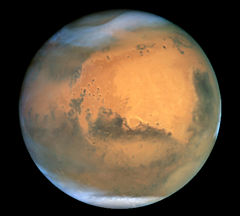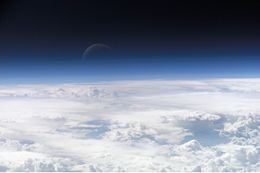Atmosphere of Mars
 |
|
| Carbon dioxide | 95.32% |
| Nitrogen | 2.7% |
| Argon | 1.6% |
| Oxygen | 0.13% |
| Carbon monoxide | 0.07% |
| Water vapor | 0.03% |
| Nitric oxide | 0.013% |
| Neon | 2.5 ppm |
| Krypton | 300 ppb |
| Formaldehyde | 130 ppb [1] |
| Xenon | 80 ppb |
| Ozone | 30 ppb |
| Methane | 10.5 ppb |
Mars, the fourth planet from the Sun, has a very different atmosphere from that of Earth. There has been much interest[1][2] in studying its composition since the recent detection of a small amount of methane,[3] which may signal life on Mars; it could also be a geochemical process or the result of volcanic or hydrothermal activity.[4]
The atmosphere of Mars is relatively thin, and the atmospheric pressure on the surface varies from around 30 Pa (0.03 kPa) on Olympus Mons's peak to over 1155 Pa (1.155 kPa) in the depths of Hellas Planitia, with a mean surface level pressure of 600 Pa (0.6 kPa), compared to Earth's 101.3 kPa, and a total mass of 25 teratonnes, compared to Earth's 5148 teratonnes. However, the scale height of the atmosphere is about 11 km, somewhat higher than Earth's 7 km. The atmosphere on Mars consists of 95% carbon dioxide, 3% nitrogen, 1.6% argon, and contains traces of oxygen, water, and methane, for a mean molecular weight of 43.34 g/mole. The atmosphere is quite dusty, giving the Martian sky a tawny color when seen from the surface; data from the Mars Exploration Rovers indicates the suspended dust particles are roughly 1.5 micrometres across.[5]
Contents |
Structure
Mars' atmosphere is composed of the following major divisions:
- Lower Atmosphere: This is a warm region affected by heat from airborne dust and from the ground.
- Middle Atmosphere: Mars has a jetstream which flows in this region.
- Upper Atmosphere, or Thermosphere: This region has very high temperatures caused by heating from the Sun. Here, atmospheric gases start to separate from each other rather than forming the even mix found in the lower atmospheric layers.
- Exosphere: 200 kilometers and higher. This region is where the last wisps of atmosphere merge into space. There is no distinct boundary where the atmosphere ends, it just tapers away.
Composition

Carbon dioxide
The main component of the atmosphere of Mars is carbon dioxide (CO2). During the Martian winter the poles are in continual darkness and the surface gets so cold that as much as 25% of the atmospheric CO2 condenses at the polar caps into solid CO2 ice (dry ice). When the poles are again exposed to sunlight during the Martian summer, the CO2 ice sublimes back into the atmosphere. This process leads to a significant annual variation in the atmospheric pressure and atmospheric composition around the Martian poles.
Argon
The atmosphere of Mars is considerably enriched with the noble gas argon in comparison to the atmosphere of the other planets within the solar system. Unlike carbon dioxide, the argon content of the atmosphere does not condense, and hence the total amount of argon in the Mars atmosphere is constant. However, the relative concentration at any given location can change as carbon dioxide moves in and out of the atmosphere. Recent satellite data shows an increase in atmospheric argon over the southern pole in autumn, which dissipates the following spring.[6]
Water
Other aspects of the Martian atmosphere vary significantly. As carbon dioxide sublimates back into the atmosphere during the martian summer, it leaves traces of water. Seasonal winds sweep off the poles at speeds approaching 400 kilometres per hour (250 mph) and transport large amounts of dust and water vapor giving rise to Earth-like frost and large cirrus clouds. These clouds of water-ice were photographed by the Opportunity rover in 2004.[7] NASA scientists working on the Phoenix Mars mission confirmed on July 31, 2008 that they had indeed found subsurface water ice at Mars' northern polar region. Further analysis by the Phoenix lander will confirm whether the water was ever liquid and if it contains organic materials necessary for life.
Methane
Trace amounts of methane, at the level of several parts per billion, were first reported in Mars' atmosphere by a team at the NASA Goddard Space Flight Center in 2003.[3][8] In March 2004 the Mars Express Orbiter [9] and ground based observations from Canada-France-Hawaii Telescope[10] also suggested the presence of methane in the atmosphere with a concentration of about 10 ppb by volume.[11] The presence of methane on Mars is very intriguing, since as an unstable gas it indicates that there must be a source of the gas on the planet. It is estimated that Mars must produce 270 ton/year of methane,[12][13] but asteroid impacts account for only 0.8% of the total methane production. Although geologic sources of methane are possible, the lack of current volcanism, hydrothermal activity or hotspots are not favorable for geologic methane. The existence of life in the form of microorganisms such as methanogens are among possible, but as yet unproven sources.
The methane appears to occur in patches, which suggests that it is being rapidly broken down before it has time to become uniformly distributed in the atmosphere, and so it is presumably also continually being released to the atmosphere. Plans are now being made to look for other companion gases that may suggest which sources are most likely; in the Earth's oceans, biological methane production tends to be accompanied by ethane, while volcanic methane is accompanied by sulfur dioxide.
It was also recently shown that methane could be produced by a non-biological process involving water, carbon dioxide, and the mineral olivine, which is known to be common on Mars.[14] The required conditions for this reaction (i.e. high temperature and pressure) do not exist on the surface, but may exist within the crust. To prove this process is occurring, serpentine, a mineral by-product of the process would be detected.
The European Space Agency (ESA) found that the concentrations of methane in the martian atmosphere was not even, but rather that it coincided with the presence of water vapor. In the upper atmosphere these two gasses are uniformly distributed, but near the surface they concentrate in three equatorial regions, namely Arabia Terra, Elysium Planitia, and Arcadia Memnonia. Planetary scientist David H. Grinspoon (Southwest Research Institute) feels that the coincidence of water vapor and methane increases the chance of a biological source, but cautions that it is uncertain how life could have survived so long on a planet as inhospitable as Mars.[8] Ultimately, to prove an organic nature for the methane, a future probe or lander hosting a mass spectrometer will be needed, since the isotopic proportions of C12 to C14 can clearly distinguish between an inorganic and an organic (biologic, e.g. bacterial decay) origin of the methane.[15] In 2010, the Mars Science Laboratory rover will measure such isotopes in CO2 and methane.[16]
Potential for utilization by humans
The atmosphere of Mars is a resource of known composition which is available at any landing site on Mars. For this reason, it has been proposed that human exploration of Mars could use carbon dioxide from Martian atmosphere as feedstock to manufacture rocket fuel to use for the return mission. Mission studies which propose using the atmosphere in this way include the Mars Direct proposal of Robert Zubrin and the NASA Design reference mission study. Two major chemical pathways for utilization of the carbon dioxide are the Sabatier reaction, converting atmospheric carbon dioxide along with additional hydrogen to produce methane and oxygen, and electrolysis, using a zirconia solid oxide electrolyte to split the carbon dioxide into oxygen and carbon monoxide.
However, if humans are to colonize Mars in the future, they would likely need as many greenhouse gases as they can get in order to maintain a warm climate. So using the Martian atmosphere as a consumable resource with no intentions of replenishing it may be considered dubious. (see terraforming mars)
References
- ↑ Life on Mars? - Geological and biological processes observed on Earth provide hunky-dory explanations for methane on Mars, Martin Baucom, American Scientist, March-April 2006.
- ↑ Interplanetary Whodunit - Methane on Mars, David Tenenbaum, Astrobiology Magazine, NASA, 20 Jul 2005. (Note: part one of a four-part series.)
- ↑ 3.0 3.1 Mumma, M. J.; Novak, R. E.; DiSanti, M. A.; Bonev, B. P., "A Sensitive Search for Methane on Mars" (abstract only). American Astronomical Society, DPS meeting #35, #14.18.
- ↑ Making Sense of Mars Methane (June 2008)
- ↑ Lemmon et al., "Atmospheric Imaging Results from the Mars Exploration Rovers: Spirit and Opportunity"
- ↑ Francois Forgot. "Alien Weather at the Poles of Mars". Science. Retrieved on 2007-02-25.
- ↑ Clouds - Dec. 13, 2004 NASA Press release. URL accessed March 17, 2006.
- ↑ 8.0 8.1 Michael J. Mumma. "Mars Methane Boosts Chances for Life". Skytonight.com. Retrieved on 2007-02-23.
- ↑ V. Formisano, S. Atreya T. Encrenaz, N. Ignatiev, M. Giuranna (2004). "Detection of Methane in the Atmosphere of Mars". Science 306 (5702): 1758–1761. doi:.
- ↑ V. A. Krasnopolskya, J. P. Maillard, T. C. Owen (2004). "Detection of methane in the martian atmosphere: evidence for life?". Icarus 172 (2): 537–547. doi:.
- ↑ ESA Press release. "Mars Express confirms methane in the Martian atmosphere". ESA. Retrieved on 2006-03-17.
- ↑ Vladimir A. Krasnopolsky (February 2005). "Some problems related to the origin of methane on Mars". Icarus Volume 180 (Issue 2): 359-367. doi:. http://www.sciencedirect.com/science?_ob=ArticleURL&_udi=B6WGF-4HTCW36-2&_user=10&_rdoc=1&_fmt=&_orig=search&_sort=d&view=c&_acct=C000050221&_version=1&_urlVersion=0&_userid=10&md5=a614a9e35a422b94cc2611ccdc4bf180.
- ↑ Planetary Fourier Spectrometer website (ESA, Mars Express)
- ↑ Oze, C., M. Sharma (2005). "Have olivine, will gas: Serpentinization and the abiogenic production of methane on Mars". Geophys. Res. Lett. 32: L10203. doi:. http://www.agu.org/journals/gl/gl0510/2005GL022691/.
- ↑ Remote Sensing Tutorial, Section 19-13a - Missions to Mars during the Third Millennium, Nicholas M. Short, Sr., et al., NASA
- ↑ Tenenbaum, David (Jun 09, 2008):). "Making Sense of Mars Methane". Astrobiology Magazine. Retrieved on 2008-10-08.
See also
- Climate of Mars
- MetNet - a wide-spread surface observation network in Mars.
- Life on Mars
- In Situ Resource Utilization
- Terraforming of Mars
- Earth's atmosphere
- Total Recall, a science-fiction film where the irrespirability of Mars' atmosphere is part of the plot.
|
||||||||||||||||||||||||||||||||||||||||||||
|
||||||||||
External links
- Mars Clouds Higher Than Any On Earth - Mars is home to the highest clouds ever discovered above the surface of a planet, Space.com
- Mikulski, Lauren (2000). "Pressure on the Surface of Mars". The Physics Factbook.
- Atmospheric pressure - summary of the Viking lander results

